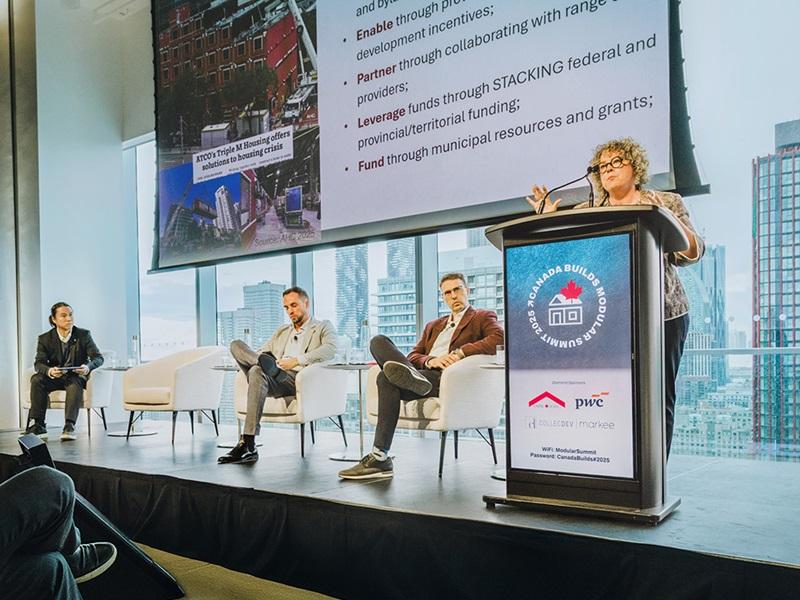
Minto Developments is proving at its newest Greater Toronto Area community that building net-zero housing can, in fact, be scaled.
The first phase of Union Village, the developer’s Unionville low-rise subdivision, includes 22 “net-zero-ready” units – meaning overall energy consumption and carbon emissions will be reduced by 60 per cent and 36 per cent, respectively – and representing up to $60,000 in upgrades.
Although the net-zero-ready purchasers declined spending an additional $60,000 to install 15.5-kilowatt solar panels – which would achieve full net-zero by producing surplus energy during summer months and offsetting their winter needs – they can add this capability later.
Minto Developments has already built net-zero homes in Ottawa, but at Union Village it unveiled a fully net-zero, 4,500-square-foot (excluding the unfinished basement) model home, demonstrating that net-zero communities are arriving in the mainstream of the home-building industry.
“It’s always been part of our core values going back even to the ‘90s. Everything before this have been one-off pilot projects with new innovative tech, but now we’ve proven we can do it at production scale, and now there’s the market interest,” Carl Pawlowski, senior manager of sustainability at Minto Communities in the GTA, told SustainableBiz.
The net-zero supporting cast
Although features like triple-pane windows aren’t new, arguably the most salient reason scaled production is possible today is that an entire supporting cast and supply chain has emerged.
From air sealing companies like AeroBarrier to consultants like Building Knowledge Canada Inc. to Bluewater Energy, a renewable energy design and installation firm, the infrastructure needed to achieve net-zero exists today.
“You bring electrical loads down and introduce high-efficiency mechanical equipment, so we’ve got the dual-fuel air source heat pump, heating and cooling combined with multi-zoned HVAC, making it more comfortable, and then there’s drain-water recovery,” Pawlowski explained. “With all this, you achieve a 60 per cent reduction in overall energy consumption and a 36 per cent reduction in carbon emission.”
Construction trades have also become familiar with these new technologies, he added.
“I think one of the biggest things we’ve seen with this home, specifically in putting this package together for the construction team, it’s not that complex from where we were seven or eight years ago,” Pawlowski said. “I talked to the construction team and nothing was too tricky.”
Construction scrambles and interest rate hikes
Also of consequence is that the Ontario Building Code is being harmonized federally. This is designed to create a tiered approach and help Canada achieve its 2030 Emissions Reduction Plan, which calls for bringing emissions 40 per cent below 2005 levels by 2030, and achieving net zero by 2050.
However, that has left the construction industry, already beset by shortages, scrambling.
“The residential construction industry, its builders, designers and manufacturers have a lot on their plates just now due to higher interest rates and a perfect storm of issues, and it would be unfair to expect them to adapt on short notice to significant changes to green building standards that are above the minimum requirements in the Ontario Building Code,” Richard Lyall, president of the Residential Construction Council of Ontario, said.
“We are all for improvements, but they need to be incremental so the industry can get it right and we can continue to build the houses and condos that are necessary to meet demand.”
Also of note is the additional cost of such homes, particularly in the country’s largest and most financially prohibitive markets. This might disabuse some homebuyers from investing in energy-efficient homes given the technology is nascent and, therefore, more costly up-front.
Moreover, the Bank of Canada’s interest rate hikes have spurred some developers, already grappling with higher material costs and other issues, to delay projects.
These factors together could imperil the realization of Canada’s looming 2030 target.
Incremental solutions to green construction
However, Mike Singleton, executive director of Sustainable Buildings Canada (SBC), recommends developers incrementally introduce green building elements into their projects as a way of evading sudden overhead surges.
“There might be other approaches to how construction is done. Panelization could be a solution as opposed to stick-built houses,” he said. “They might want to start looking into other solutions that offer all kinds of other benefits, in terms of speed, reduction of material waste, and other things.
"That represents quite a bit of change in process for them, but they could use this time to think about how to minimize cost with the end goal in mind.”
It is SBC’s experience, Singleton said, that the incremental approach is effective.
“For example, a better-performing building envelope means lower heating and cooling loads, which translates into smaller heating and cooling equipment at lower costs,” he said. “That’s how the bigger picture cost savings benefit can play out.”
While Pawlowski acknowledged the building industry hasn’t had much time to adapt to the imminent new reality, it does give companies such as Minto, which formalized and released its ESG strategy two years ago, a leg up on much of its competition. Targets around operational and embodied carbon are a key element within Minto's strategy – but not all companies have reached that stage.
“That doesn’t give the industry enough time to transition to (2030 targets), and that’s why we’re focused on that now,” he said. “It gives us an edge across the stumble to get there."







